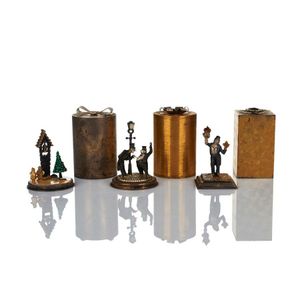Victorian Sterling Silver Traveling Communion Set with Crystal Ewer
You must be a subscriber, and be logged in to view price and dealer details.
Subscribe Now to view actual auction price for this item
When you subscribe, you have the option of setting the currency in which to display prices to $Au, $US, $NZ or Stg.
- Sterling Silver - Sterling silver is a mixture of 92.5% pure silver and 7.5% of another metal, usually copper. Fine silver is 99.9% pure silver, and is relatively soft and the addition of the very small amount of copper gives the metal enough strength and hardness to be worked into jewellery, decorative and household objects.
- Ewer / Pitcher - A type of jug with a narrow neck bulbous body and wide spout, originally used for carrying and storing liquids such as water or wine. In medieval times they were the source of water to wash ones hands during and after a meal. later the shape was used for vessels in silver, gold, glass and ceramics.
In Victorian times they were made in ceramics and occasionally glass with a matching basin, and sometimes other accessories such as a soap holder or toothbrush holder. Their purpose was to provide facilities for personal washing In the early 19th century were often enclosed in purpose built stands, and later resided on a washstand..
Sometimes the words "ewer" and "pitcher" are used interchangably, but a pitcher is generally considered to be a jug, and would have a wide mouth, and a gently tapering body. - Victorian Period - The Victorian period of furniture and decorative arts design covers the reign of Queen Victoria from 1837 to 1901. There was not one dominant style of furniture in the Victorian period. Designers used and modified many historical styles such as Gothic, Tudor, Elizabethan, English Rococo, Neoclassical and others, although use of some styles, such as English Rococo and Gothic tended to dominate the furniture manufacture of the period.
The Victorian period was preceded by the Regency and William IV periods, and followed by the Edwardian period, named for Edward VII (1841 ? 1910) who was King of the United Kingdom and the British Dominions and Emperor of India for the brief period from 1901 until his death in 1910.
This item has been included into following indexes:
- oriental objects - boxes 1,766
Visually similar items

Stuart Devlin, three silver and silver-gilt Christmas Carol boxes, comprising: God rest Ye Merry Gentlemen, London 1972, the Holly and the Ivy, London 1975 and Ding Dong Merrily on high, London 1978 each numbered 137 of an edition of 500, hallmarked, with

A Victorian brass monocular microscope, the adjustable sectional top with viewing lens above the circular slide viewing platform and lower, wider conforming base with gimbal mounted mirror, both with three scroll arm supports, in an original mahogany four

Two Charles Rennie Mackintosh pewter perfume bottles, of Art Nouveau design. Heights 14.5 and 11.5 cm

Continental pair of silver candlesticks with snake supports, 16.5 cm high
